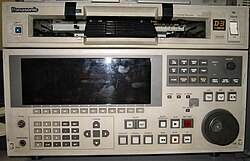D-3 (video)
 A D-3 videocassette | |
| Media type | Magnetic tape |
|---|---|
| Encoding | NTSC,PAL |
| Readmechanism | Helical scan |
| Writemechanism | Helical scan |
| Standard | Interlaced video |
| Developedby | NHK |
| Usage | Television production |
| Extendedto | D-5 |

D-3is anuncompressedcompositedigital videoformat invented atNHKand introduced commercially byPanasonic.It was launched in 1991 to compete withAmpex'sD-2.
D-3 uses half-inchmetal particle tapeat 83.88 mm/s (compare to D-2's 19 mm and 131.7 mm/s). Like D-2, thecomposite videosignal is sampled at four times the color subcarrier frequency, with eight bits per sample. Four channels of 48 kHz 16–20 bit PCM audio, and other ancillary data, are inserted during thevertical blanking interval.The aggregate net (error corrected) bitrate of the format is 143 Mbit/s, and because the codec is lossless, it has been used in data applications.
Camcorderswere available which used this format, and are to date the only digital tape camcorders to use a lossless encoding scheme. TheD-5digital component video format, introduced in 1993 by Panasonic, uses the D-3 transport and tape running at roughly double D-3 speed. The D-3 transport in turn is derived from theMIItransport. D-3/D-5 tapes come in small (161 mm × 96 mm × 25 mm), medium (212 mm × 124 mm × 25 mm), and large (296 mm × 167 mm × 25 mm) cassettes, with format-specific recognition holes. Maximum D-3 runtimes (in the Fujifilm lineup) are 50, 126, and 248 minutes.
The D-3 format is now regarded as obsolete. In the early 1990s theBBCembarked on a massive project to copy its older video tapes onto D-3 for archival, but the D-3 cassettes themselves have become obsolete and are being transferred to modern digital video standards. There is doubt[1]over whether the surviving D-3 machines will last long enough to play the 340,000 tapes which the corporation holds.[2]
References[edit]
- ^"Histories of digital video tape".14 July 2014.Retrieved2017-09-19.
- ^"BBC Academy - Technology - Digitising the BBC archive".Archived fromthe originalon 2017-04-25.Retrieved2016-05-14.
